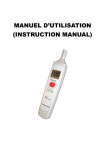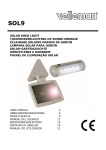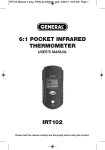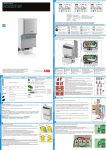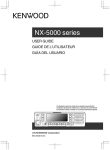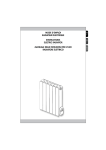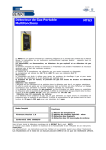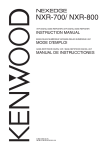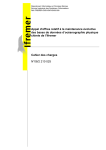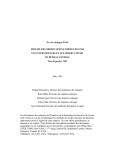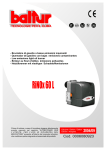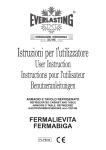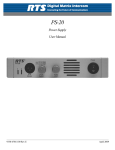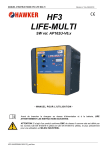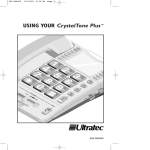Download manuale G1.cdr
Transcript
CARICABATTERIE AUTOMATICO CHARGEUR AUTOMATHIQUE AUTOMATIC BATTERY CHARGER MOD. ITALCAR INDUSTRIAL S.r.l. Via Reano, 18 - 10040 Rivalta di Torino - TO - (ITALIA) Tel. +39 011 9040225 - Fax +39 011 9032986 [email protected] www.itarcar.com G1 NORME D’USO MODE D’EMPLOI INSTRUCTIONS INFORMAZIONI GENERALI Questo apparecchio permette la ricarica di batterie al piombo a elettrolito libero comunemente utilizzate nel settore della trazione elettrica. La corrente di carica è autodecrescente (DIN 41774). Il contenitore e le parti metalliche in esso contenute sono messe a terra come prescritto dalle normative vigenti. PRECAUZIONI L’apparecchio non deve essere usato per altri scopi se non quello per cui è stato costruito; es: non deve essere utilizzato come alimentatore per lampade, autoradio o altri accessori, (il costruttore declina qualsiasi responsabilità per eventuali danni arrecati da un uso scorretto o improprio). Non deve essere utilizzato allo scoperto o in ambienti che lo espongano a spruzzi, pioggia, neve, nebbia o altri eventi che potrebbero danneggiarlo o comprometterne la sicurezza. Durante la carica le batterie emanano gas esplosivi (non avvicinarsi con fiamme libere, non fumare) quindi scegliere ambienti dove esista un buon ricambio d’aria e non collocare il caricabatterie troppo vicino, in quanto alcuni componenti durante il loro normale funzionamento generano archi voltaici. Controllare che la tensione e la corrente di carica dell’apparecchio siano appropriate alla batteria alla quale viene collegato. Qualora si dovessero riscontrare anomalie o manca to funzionamento non accedere all’interno del caricabatterie ma rivolgersi al punto vendita o a personale qualificato per tali interventi. DICHIARAZIONE DI CONFORMITA’ Dichiariamo sotto la nostra responsabilità che l’apparecchio accompagnato dalla presente dichiarazione di conformità, identificato per modello, codice e matricola (vedi talloncino sottostante) è stato costruito in osservanza delle attuali legg i in vigore, come descritto nella documentazione conservata presso la nostra sede; ed è in conformità con le seguenti direttive comunitarie: 73/23/CEE e s.m.i. bassa tensione 89/336/CEE e s.m.i. compatibilità elettromagnetica (per la parte applicabile) 93/68/CEE di modifica alle precedenti direttive e in accordo alle norme EN 60335-1, EN 60335-229 (per la parte applicabile) DÉCLARATION DE CONFORMITÉ Nous déclarons sous notre responsabilité que l’appareil avec cette déclaration de comformité, identifié par modèle, code et matricule, a été fabriqué en observance des lois actuellment en vigueur, comme décrit dans la documentation conservée chez notre bureau; et il est en conformité avec les suivantes directives de la Communauté Européenne : 73/23/CEE basse tension 89/336/CEE compatibilité électromagnétique (pour la partie applicable) 93/68/CEE de modification aux dernières directives et en accord aux réglementation EN 60335-1, EN 60335-2-29 (pour la partie applicable) COMFORMITY DECLARATION We declare on our own responsability that the devices with this conformity declaration, identified by model, code and number has been designed in compliance with the present law in force, as described in the documentation preserved at our office; and it is in conformity with the following directives of the European Community: 73/23/CEE low tension 89/336/CEE electromagnetic compatibility (for the enforceable part) 93/68/CEE of modification to previous directives and in accordance with the regulations EN 60335-1, EN 60335-2-29 (for the enforceable part) INSTALLAZIONE Se non presente installare una spina sul cavo di alimentazione (rispettando scrupolosamente il collegamento di terra ) di portata adeguata alla potenza dell’apparecchio in questione. Assicurarsi che la presa alla quale verrà collegato il caricabatterie sia di potenza adeguata e che sia presente il collegamento di terra; accertare pure che la tensione fornita dall’impianto sia quella richiesta per l’alimentazione dell’apparecchio. Installare sui cavi batteria un connettore irreversibile appropriato alle esigenze e alla corrente di carica, rispettando attentamente la polarità indicata. Made in Italy Non smaltire come rifiuto urbano, conferire a centri autorizzati per la raccolta differenziata. Lo smaltimento abusivo è sanzionato in quanto nuoce all’ambiente. OPERAZIONI PRELIMININARI Aver cura di mantenere puliti i contatti del connettore. Controllare il livello del liquido della batteria (deve coprire le piastre, in caso contrario aggiungere acqua distillata fino a raggiungere il livello ottimale) nell’eseguire tale operazione munirsi di guanti, per evitare di venire a contatto con l’acido della batteria che è corrosivo. Ne pas jeter avec vos déchets normaux domestiques. Attention, apportez-les dans une déchetterie pour étre recyclé. Sachez qu’il est interdit et punissable par la loi de déposer des déchets nuisibles à l’environnement. Please do not dispose with your domestic garbage, bring it to an authorized centre for the separate disposal of waste. The illegal disposal of waste will be punished because it is hazardous for the natural environment. CERTIFICATO DI GARANZIA La ditta costruttrice garantisce il buon funzionamento del prodotto e si impegna ad effettuare gratuitamente riparazioni o sostituzioni delle parti che risultino difettose o deteriorate entro 12 mesi dalla data di acquisto, comprovata dalla compilazione del presente certificato che dovrà accompagnare sempre il prodotto. Tutti gli eventuali guasti derivanti da uso improprio, manomissione o incuria, sono esclusi dalla garanzia. Si declina ogni responsabilità per eventuali danni diretti ed indiretti cagionati a persone, animali o cose, causa la non osservanza delle norme allegate. I resi, anche in garanzia dovranno pervenire in porto franco e verranno restituiti in porto assegnato. N.B. Il presente certificato è valido per la richiesta di intervento in garanzia solo se debitamente compilato e accompagnato da scontrino fiscale o d.d.t. . BULLETIN DE GARANTIE Le fabricant garantit un bon fonctionnement du produit et s’engage à faire gratuitement les réparations des éléments endommagés ou détériorés dans 12 mois de la date d’achat, attestée par la compilation de ce bulletin qui devra accompagner toujours l’appareil. Toutes les pannes éventuelles dérivantes pour l’usage impropre, altération, ou bie n incurie, sont exclues de la garantie. On décline toute résponsabilité en cas de possibles dommages directs et indirects causés à personnes, animaux ou choses, pour ne pas avoir observé les normes ici incluses. Les appareils refusés, mème si en garantie, vont rendus en port franc chez notre usine et seront remis en port dù chez votre maison. N.B. Le present bulletin de garantie est valide seulement si dùment rempli et accompagné avec un bon de livraison. WARRANTY CERTIFICATE The Firm warrants the goodsfunctioning of the devices and engages to repair gratis or to replace those faulty or demaged components within one year from purchase date, confirmed by the compilation of this warranty certificate that will be always to accompany the device. The warranty certificate does not cover materials undergoing self consumption and damages resulting from improper handling, lack of care, manumission, accidents, as well as possible consequential damage resulting from the inaccuracy or the non functioning of the cha rger, or actions contrary to the Company’s operating instructions. The Firm declines all responsability for possible direct and indirect damages caused to people, animals or things, by the non- compliance with the enclosed instructions for use. The refused devices, even if under manufacturer’s warranty, will be to return free port and will be rendered carriage on delivery. N.B. This warranty certificate is valid only if duly completed and associated by cash voucher or by delivery note. ITALCAR INDUSTRIAL S.r.l. Via Reano, 18 - 10040 Rivalta di Torino - TO - (ITALIA) Tel. +39 011 9040225 - Fax +39 011 9032986 [email protected] www.itarcar.com IT 1 – Amperometro 3 - Spia carica finale 5 - Cavi per collegamento batteria 7 - Commutatore (MIN - MAX) 9 - Cavo c/spina 2 - Spia carica voltmetrica 4 - Spia fine carica 6 - Protezione termica 8 - Interruttore 10 - Portafusibile COLLEGAMENTI E CARICA 1 - Controllare che la tensione monofase di rete sia 230V. e che la presa sia munita del terminale di terra di sicurezza. 2 - Controllare che il modello di apparecchio corrisponda per tensione e corrente alle caratteristiche della batteria che si deve ricaricare. Collegare il connettore alla batteria, simultaneamente si accende la spia carica voltmetrica. 3 - Inserire la spina nella presa di corrente, posizionare il commutatore di regolazione (MIN - MAX) su MIN, quindi accendere l’apparecchio portando l’interruttore ON /OFF sulla posizione ON , l’accensione è segnalata dalla spia dell’interruttore, e l’amperometro indica la corrente di carica. Se la corrente di carica indicata dall’amperometro risulta troppo bassa, aumentare posizionando il commutatore di regolazione su MAX. La corrente di carica diminuisce con il passare del tempo in funzione dello stato di caric a della batteria, raggiunto il valore di 2,42 V. per elemento si spegne la spia carica voltmetrica e si accende lampeggiando la spia carica finale a segnalare che è entrato in funzione un timer elettronico il quale spegne l’apparecchio dopo 3,30 h. circa e accende la spia fine carica, che indica che il ciclo di carica è terminato. Se la tensione della batteria non raggiunge i 2,42V per elemento entro 16 ore dall’inizio della carica l’apparecchio si spegne, segnalando con l’accensione permanente della spia carica finale che il ciclo si è concluso in modo anomalo. 4 - A carica ultimata prima di scollegare la batteria ricordarsi sempre di spegnere l’apparecchio e scollegare la spina dalla presa di corrente. IT L’apparecchio è dotato di una protezione che spegne l’apparecchio nel caso in cui mancasse la connessione alla batteria. L’apparecchio è dotato di una protezione termica con riarmo manuale a pulsante che provvede a interrompere la carica quando questa risulti troppo gravosa ( es: batteria difettosa, tensione di alimentazione troppo alta, cortocircuito, regolazione di carica eccessiva ecc.) Per ripristinare la carica, attendere due minuti circa, premere leggermente il pulsante della protezione il quale rientra nella sua sede e controllare che l’apparecchio eroghi corrente entro i parametri consentiti. L’apparecchio è dotato di fusibile di alimentazione. Se dovete sostituire il fusibile, accertate che l’apparecchio sia spento e scollegato dalla rete e dalla batteria. Attenzione - non ostruire le bocchette o i fori di ventilazione quando l’apparecchio è acceso, un surriscaldamento eccessivo potrebbe comprometterne il funzionamento o la sicurezza. - evitare di invertire la polarità nel collegamento alla batteria - non inserire la spina prima di collegare il connettore alla batteria - spegnere e disinserire sempre la spina prima di scollegare la batteria. Difetti e rimedi - l’apparecchio non eroga corrente (la spia dell’interruttore è spenta) 1) controllare che la spina sia bene inserita nella presa di corrente - l’apparecchio non eroga corrente (l’ago dell’amperometro rimane a zero, la spia dell’interruttore è accesa ma la spia carica voltmetrica è spenta) 1) i terminali del connettore non fanno contatto (pulire i punti di contatto) 2) la protezione termica è intervenuta bloccando l’uscita della corrente (ripristinare) - l’apparecchio non eroga corrente (l’ago dell’amperometro rimane a zero, la spia dell’interruttore e la spia carica voltmetrica sono accese) 1) il fusibile di alimentazione è bruciato (sostituire) 2) la batteria potrebbe essere interrotta o solfatata (rivolgersi all’assistenza per un controllo) 3) il caricabatterie è guasto (rivolgersi all’assistenza, non improvvisare riparazioni che potrebbero compromettere oltre all’efficienza anche la sicurezza dell’apparecchio). - la spia carica finale non si accende 1) corrente di carica troppo bassa dovuta a insufficienza di rete 2) batteria con uno o piø elementi difettosi che assorbono corrente ma non alza no il valore di tensione complessivo (controllare la batteria) 3) alterazione della taratura del dispositivo automatico (rivolgersi esclusivamente all’assistenza ). Elenco ricambi serie G1 I TR PD A Interruttore Trasformatore Ponte Diodi Amperometro D F S3.1 PT Commutatore MIN – MAX Fusibile alimentazione Dispositivo automatico Protezione termica N.B. : nella eventuale richiesta di parti ricambio oltre alla descrizione del componente citare sempre il numero di codice e matricola im presso sulla targa di identificazione dell’apparecchio. FR INFORMATIONS GENERALES Cet appareil est destiné à étre utilisé pour la recharge de batteries au plomb ou à électrolyte libre usagées dans le domaine de la traction électrique. Le courant est auto décroissant (DIN 41774). Le boîtier et ses parties ont le contact de terre, comme selon les normes. PRÉCAUTIONS Le chargeur de batteries ne doit jamais étre utilisé pour des buts différents de ceux pour lesquels il a été fabriqué. Il ne doit pas alimenter des lampes, des radios ou autres (le fabricant décline toutes responsabilités en cas de dommage causé à l’appareil ou en cas d’usage impropre) N’exposé pas l’appareil à jets d’eau, à la pluie, à la neige ou au brouillard, puisque ces agents pourraient endommager l’appareil et aussi sa sécurité pourrait étre compromise. Pendant la charge les batteries dégagent des gaz inflammables (ne vous approchez pas avec des flammes libres ou d’étincelles. Ne fumez pas). Il va mieux, alors, choisir des places aérées et ne placez pas le chargeur près de la batterie puisque certains composants provoquent des arcs voltaïques pendant leurs normal fonctionnement. Contrôlez que la tension et le courant de charge de l’appareil sont aptes à la batterie qu’on vient de connecter. En cas de disfonctionnement il faut s’adresser au distributeur ou à des techniciens. Si l’appareil ne marche plus, ou fonctionne irrégulièrement ne pas ouvrir le boîtier. INSTALLATION Placez une fiche sur le câble d’alimentation (en faisant attention à la connexion de terre), apte à la puissance de l’appareil . Contrôlez que le socle de courant qu’on veut utiliser ait le contact de terre et une puissance apte; contrôlez aussi que la tension du réseau soit apte à l’alimentation de l’appareil. Placez sur les câbles de la batterie un connecteur irréversible apte au courant de charge, en faisant attention aux polarités. OPERATIONS PRELIMINAIRES Prendre soin de bien nettoyer les terminales du connecteur. Contrôlez le liquide de la batterie (il faut qu’il couvre les plaques, au contraire ajouter de l’eau distillé jusqu’à rejoindre le niveau indiqué sur le boîtier de la batterie). En opérant dans cette façon il faut utiliser des gants au fin d’èviter des contac ts avec l’acide de la batterie qui est très dangereux. 1 - Ampèremètre 2 - Indicateur lumineux de charge voltmètric 3 - Indicateur lumineux de charge finale 4 - Indicateur lumineux de fin de charge 5 - Câbles pour la connexion à la batterie 6 - Disjoncteur thermique 7- Commutateur (MIN – MAX) 8 - Interrupteur 9 - Câble avec fiche 10 - Porte fusible CONNEXIONS ET CHARGE 1 - Contrôlez la tension monophasé du réseau : elle doit étre 230V. Contrôlez aussi que le socle de la prise du courant ait un contact de terre approprié. 2 - Contrôlez que l’appareil correspond par tension et courant aux caractéristiques de la batterie qu’on va recharger. Connecter le connecteur à la batterie, en méme temps l’indicateur lumineux de charge voltmètric s’allume. 3 - Connectez la fiche au la socle de prise de courant, placez le commutateur de régulation (MIN - MAX) sur MIN, allumer l’appareil en plaçant l’interrupteur sur la position ON, l’indicateur lumineux de l’interrupteur signale que l’appareil est allumé et l’ampèremètre signale le courant de charge. Si le courant de charge indiqué par l’ampèremètre est trop baisse augmentez-le en plaçant le commutateur de régulation sur MAX. Le courant de charge décroît pendant le temps en fonction de l’état de charge de la batterie, quand le valeur de 2,42V. par élément est rejoint, l’indicateur lumineux du charge voltmètric s’éteint, et l’indicateur lumineux de charge finale s’allume en clignotant à signaler que le timer électronique est entré en fonction et il éteindra l’appareil après 3.30 h. et l’indicateur lumineux fin de charge s’allumera à indiquer que le cycle de charge est terminé. Si la tension de la batterie ne rejoint pas le valeur de 2,42V. par élément dans 16 h. de commencement de la charge l’appareil s’éteint, et avec l’indicateur lumineux de charge finale allumé s’indique que la cycle de charge est terminé en façon anomale. FR 4 - Quand la charge est terminée, avant de débrancher le connecteur, arrét tez l’appareil en plaçant l’interrupteur sur OFF et débranchez la connexion du socle de courant. L’appareil est doué d’une protection qui arréte l’appareil en cas la connexion à la batterie vient à manquer. L’appareil est aussi doué d’un disjoncteur thermique avec rétablissement manuel qui coupe la charge si elle est trop lourde (ex : batterie ennuyée, tension d’alimentation trop haute, court-circuit, régulation de charge excessive, etc…). Pour reprendre la charge attendez quelques minutes et puis poussez doucement le bouton du disjoncteur : celui ci retourne dans sa place et contrôlez que l’appareil donne courant comme selon les paramètres. L’appareil est doué d’un fusible d’alimentation. S’il faut substituer le fusible, contrôlez que l’appareil est éteint et débranché du réseau et de la batterie. Attention - N’obstruez jamais les trous de ventilation quand l’appareil est en marche, un excessif sur chauffage peut compromettre le fonctionnement ou la sécurité de l’appareil. - N’inversez jamais les polarités pendant la connexion de la batterie. - N’insérez pas la fiche dans la socle de prise de courant avant de connecter le connecteur à la batterie. - Arrét ez et débranchez la fiche de courant avant de déconnecter la batterie. Ennuis et remèdes - Il n’y a pas de courant en sortie (l’indicateur lumineux de l’interrupteur est éteint) 1) Contrôlez que la fiche soit bien insérée dans le socle de la prise de courant - Il n’y a pas de courant en sortie (l’aiguille de l’ampèremètre est au zéro mais le signal lumineux de l’interrupteur est allumé et l’indicateur de charge voltmètric est éteint) 1) les terminales du connecteur ne font pas contact (nettoyez les terminales du connecteur ) 2) le disjoncteur thermique a coupé la sortie de courant (repositionner) - Il n’y a pas de courant en sortie (l’aiguille de l’ampèremètre est au zéro mais le signal lumineux de l’interrupteur et l’indicateur de charge voltmètric sont allumés. 1) Le fusible d’alimentation est coupé (substituer) 2) La batterie pourrait étre coupée (s’adresser au technicien) 3)Le chargeur est endommagé (s’adresser au distributeur, ne pas faire des tentatives d’entretien qui peuvent compromettre l’efficacité de l’appareil). - L’indicateur lumineux de charge finale ne s’allume pas 1) Le courant de charge est trop baisse à cause d’ un réseau insuffisant 2) Batterie avec un ou deux éléments ennuies qui absorbent courant mais n’augmentent pas le valeur de tension (contrôlez la batterie) 3) Anomalie dans la ratures du dispositif (s’adresser à des techniciens) Liste des pieces detachees mod. G1 I TR PD A Interrupteur Transformateur Pont à diodes Ampèremètre D F S3.1 PT Commutateur MIN – MAX Fusible d’alimentation Dispositif automatique Disjoncteur thermique En cas de demande d’éléments de rechange, indiquer toujours le numéro de code et matricule imprimés sur la plaque d’identification de l’appareil, outre à la des cription du composant. GENERAL INFORMATION GB This electrical device enables the recharge of lead batteries, usually used in the electric traction field. The current of charge is auto-decreasing (DIN 41774). The box and its metal parts are ground connected as per the rules in force. CAUTION This battery charger must not be used for any other purposes but for those it has been built. - It must not be used to supply electric lamps, car radios or other devices (the constructor declines any responsibility for any damage caused by improper use.) - It must not be used outside or anywhere there may be humidity, rain, snow, fog, or any agent which may cause damage or may affect the safety. - During the charging phase, batteries exhale explosive gas (do not get any near it with a flame; do not smoke): that’ s why to it is better to settle it in places where the air can be regularly changed, and do not place the battery charger too near the battery as some components generate voltaic arches during their normal functioning. - Check that the tension and the current of charge of the electrical device are suitable to the battery to which it will be connected. - In case you should notice anomalies or misfunctionings do not try to get inside the battery charger, but go to the nearest selling point or address to qualified engineers for these intervenctions. INSTALLATION If you must put a plug on the supply wire, be careful to the ground "green and yellow" connection, and thus choose a plug suitable to the power of the elctrical device. Be sure that the socket to which the battery charger will be connected has a suitable power and that the ground connection exhists; check, as well, that the tension supplied by the system is that required by the supply of the battery charger. Put on the exit wires of the battery charger an irreversible polarized connector suitable for the requires and for the current of charge, being as well careful to the polarity shown. PRELIMINARY OPERATIONS Take care of the contacts of the connector and keep them clean. Check the level of the battery liquid (it must be over the plates, if not, add some distilled water until an acceptable level will be reached). When operating as said, wear rubber gloves in order to avoid a contact with the battery acid which is highly corrosive. 1 - Ammeter 3 - Final light 5 - Wires for battery connections 7 - Switch (MIN - MAX) 9 - Wire with plug 2 - Voltmetric light 4 - Charged light 6 - Thermic protection 8 - Switch (ON - OFF) 10 - Supply fuse CONNECTIONS AND CHARGE 1 - Check that the single phase tension of the system is 230V and that the socket has the safety ground terminal. 2 - Check that the battery charger model is suitable for tension and current to the characteristics of the battery which you must recharge. Connect the electric device to the battery, at the same time the voltmetric light will switch on. 3 - Plug the battery charger and set the (MIN-MAX) regulation switch on the MIN position. Switch on the battery charger by setting the switch on the ON position. When the instrument is on, a signalling light on the switch will flash and the ammeter will show the current supplied. If the current of charge shown by the amm eter is too low, set the regulation switch on the MAX position. The current of charge decresas as time goes on, according to the state of charge of the battery. Once the 2.42V value for each element is reached, the voltmetric light switches off and the final light switches on flashing, in order to signal that an electronic timer is now working and it will switch the electrical device off after 3.30 hours roughly, thus switching on the charged light showing that the charged cycle has ended. If the battery te nsion does not reach the value of 2.42V. for each element within 16 hours from the starting of the recharge, the device switches off, in signalling, with the final light permanently turned on, that the charge cycle is concluded in anomalous way. 4 - Before disco nnecting the battery, once the charge has been done, always remember to switch this electric device OFF and to unplug it. GB The device has been equipped with a protection stopping the output current in case there was wanting the connection with the battery. This electrical device has a thermic protection with manual reset which will suspend the charge when this goes over (eg. faulted battery, too high alimentation tension, short circuit, eccessive charge regulation, etc...). In order to restore the charge, wait for two minutes roughly, then slightly push the button of the protection which will go back in its original position, and check if the battery charger delivers current inside the allowed parameter. The device has an input protection with a fuse. In case you need replacing the fuse, make sure that the device is switched OFF, that it is unplugged from the system and that the connector is disconnected from the battery. Caution - do not obstruct the ventilation holes when this electric device is on: over-heating it could affect its functioning and its safety. - avoid inverting the polarities while connecting to the battery. - do not plug it before connecting the battery. - switch it off and always unplug it before disconnecting the battery. Faults and remedies - This electric device does not deliver current (the signalling light on the switch is off) 1) check that the plug is properly plugged in the socket - The battery charger does not deliver current (the pointer of the ammeter is on the zero position, the signalling light on the switch is on but the voltmetric light is off). 1) the terminals of the connector do not create a contact (clean the terminals) 2) the thermic protection is stopping the exit of the current (reset). - The battery charger does not deliver current (the pointer of the ammeter is on the zero position, the signalling light on the switch and the voltmetric light is on). 1) the supply fuse is cut off (replace with a new one of the same value. 2) the battery could be faulted (address to customer service for a check up). 3) the battery charger is damaged (address to customer service for a check up, do not try to mend it because this operation could affect not only its reliability but its safety too). - The final light does not switch on. 1) the current of charge is too low due to a deficiency in the system. 2) battery with one or more damaged elements which absorb current but do not increase the tension value all together (check the battery). 3) alteration of the calibration of th e electronic automatic control (only go to the customer service). List of spare parts in the G1 series I TR PD A Switch ON – OFF Transformer Diode bridge Ammeter D F S3.1 PT Switch MIN - MAX Supply protection Automatic control Thermic protection Please note: In case you should need any spare elements, further to the description of the components required, mention the code and the serial number printed on the identification plaque of the battery charger.








